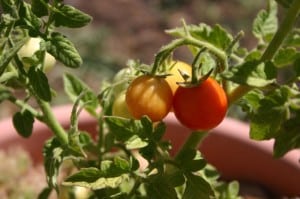Growing Cherry Tomatoes

Cherry tomatoes are one of the most popular of salad garnishments and are also handy for tossing into wrapped sandwiches or as just a snack. They are small, tasty, and easy to grow indoors or out. Here are the basics of what you need to know about growing cherry tomoates.
Growing Conditions for Cherry Tomatoes
Cherry tomatoes, like most other tomato varieties, require direct sunlight (outdoors or in a window) and warm temperatures (70F or higher is best). They also require nutrient-rich soil, plenty of water, and some care. If you can meet the heat and light requirements, have access to good potting soil, and remember to water them often, you can easily grow cherry tomatoes.How to Plant Cherry Tomatoes
When planting outdoors, cherry tomatoes should be planted in small groups (3-4 seeds per hole) at about three feet apart. When the sprouts come through the soil, thin the plants to one per position and when the plants get a few inches high, add a stake or training trellis to keep them upright.If growing indoors, you’ll want to use the same planting method in pots about the size of a large coffee can (roughly a gallon). Tomatoes have fairly deep roots and need a lot of nutrition, so you’ll need enough soil to support that. Your tomatoes will need to be grown in direct sunlight once the sprouts appear and will require watering every other day once the plant is established. Again, supports or tomato cages will be needed.
Care of Cherry Tomatoes
Once the plants establish, care will mostly involve watering and adjusting the plants occasionally on their supports. Felt or other gardener’s ties to attach the plants to poles are most common and will need to be undone and re-attached as the plant grows through them. Most tomato varieties are fairly viney can be trained onto wire trellises as well.Most cherry tomato plants are bushes and are meant to trail along the ground in nature (hence the supports). This means they’ll be top-heavy, so plan to not only provide support, but also to spend a little time trimming as the plant grows. Lower stems on the plant should be pinched or cut back to keep them from spreading and wasting plant energy. Upper branches will likely produce fruit on every other stem, but do not pinch or cut back the non-bearing limbs as they will contain the leaves needed to catch sunlight to grow the tomatoes.
Cherry Tomatoes Pests and Diseases
Most common tomato pests will also attack cherry tomato plants. They are also more susceptible to birds, who sometimes find the red cherries irresistible. Many growers spray their tomato plants liberally with soap-based insecticides (which are biodegradable and non-toxic) to keep mites, caterpillars, and other pests at bay.Indoor growers will have few enemies to contend with, though over-watering or too-humid air could lead to mold on the undersides of leaves. This can be easily avoided by being careful about watering.
Harvesting Cherry Tomatoes
Tomatoes will begin to ripen after about two to three months, depending on growing conditions. They can be picked when they are almost entirely red and will not likely all ripen at the same time on all plants. Often, you can harvest two or even three times from one plant over a four month period.Harvest the cherries by grasping them just above the stem where it enters the tomato and pushing upwards, at an angle from the stem. A natural break point is present, just as on full-sized tomatoes, and will snap off keeping the stem intact to the fruit. Cherry tomatoes should be handled gently.
Choosing Cherry Tomato Varieties
Best Cherry Tomato Varieties for the GardenNearly any type of cherry tomato variety is good for the garden. Be leery of those made for indoor growth, however, as they may not be as hardy in the rigors of outdoor life. Sun gold is probably the most common outdoor variety grown.
Any cherry tomato can be grown indoors. The most popular is the Sweet hundred variety, especially amongst hydroponics growers and others who don’t mind the wide bush this plant can become.
No comments:
Post a Comment